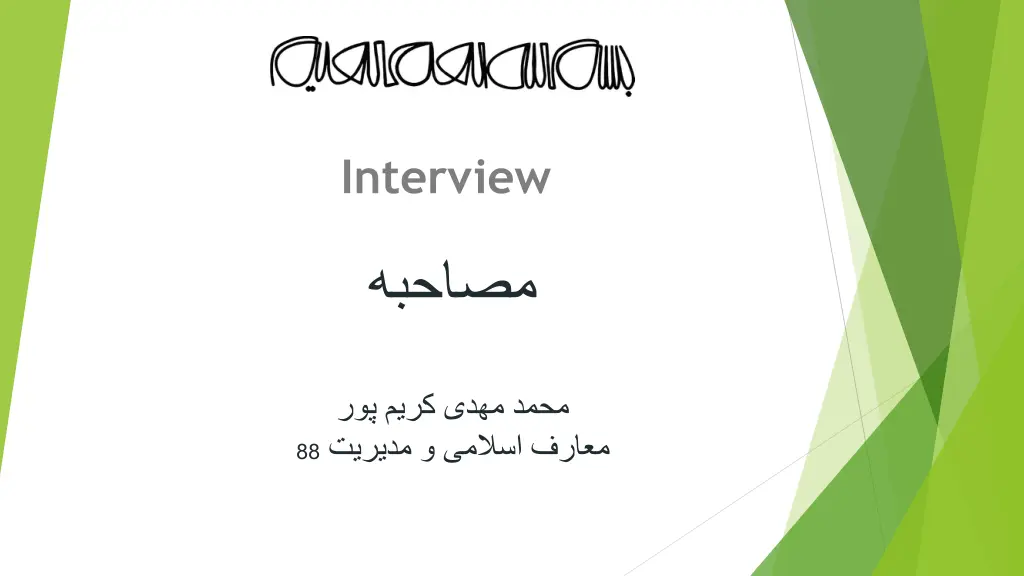
Understanding Interviews in Social Research
Interviews in social research serve as a structured framework for respondents to express their thoughts, aiding in collecting valuable information. This article explores the purpose, required skills, types, differences between quantitative and qualitative approaches, and the advantages/disadvantages of interviews. Discover how interviews are used, their position in research methods, and key considerations for successful implementation.
Download Presentation

Please find below an Image/Link to download the presentation.
The content on the website is provided AS IS for your information and personal use only. It may not be sold, licensed, or shared on other websites without obtaining consent from the author. If you encounter any issues during the download, it is possible that the publisher has removed the file from their server.
You are allowed to download the files provided on this website for personal or commercial use, subject to the condition that they are used lawfully. All files are the property of their respective owners.
The content on the website is provided AS IS for your information and personal use only. It may not be sold, licensed, or shared on other websites without obtaining consent from the author.
E N D
Presentation Transcript
Interview 88
What is the Interview? Their main function is to provide a framework in which respondents can express their own thoughts in their own words Interviews are not just conversations. They are conversations with a purpose to collect information about a certain topic or research question The A-Z of Social Research
Required skills for interviewer: Establishing trust and familiarity demonstrating genuine interest in what the respondent says appearing non judgmental effective balance between talking and listening remembering what the respondent has said knowing when and when not to interrupt The A-Z of Social Research
Use of Interview: Interviews are used both in quantitative and qualitative research Quantitative interviews use of a structured survey same questions in the same order responses are amenable to statistical analysis Qualitative interviews more flexible and open-ended used to develop ideas and research hypotheses rather than to gather facts and statistics The A-Z of Social Research
Difference between quantitative and qualitative: quantitative Number of respondent qualitative Depth of information
Position of the Interview Often combine with other methods. used to ensure that the questions that will appear in a widely circulated questionnaire are valid and Understandable used as follow-up to a questionnaire explore in more depth interesting issues from the standard questionnaire development of new ideas and hypotheses and throw up new dimensions to be studied. complement questionnaire data The A-Z of Social Research
Advantages of interviews Flexibility High response rate Check on questions Probes Clarification Confirmation Prompts Connecting Non-verbal communication Timing of interview The A-Z of Social Research
Disadvantages of Interviews Reliability Lack of comparability Time consuming Costly Interruptions Lack of anonymity The A-Z of Social Research
Interviewer effects First appearances are very important as they may influence how people respond to one another Preconceived notions may also exist among interviewees. The interviewee may have certain conceptions of the interviewer based on appearance and demeanour The A-Z of Social Research
Types of the Interview Structured semi-structured Unstructured Structured semi-structured Structured The A-Z of Social Research
Structured Interview similar to questionnaires: standard format pre-determined questions in a fixed order equal opportunities for all persons draw constructs embedded in one s thinking and rationale for decision making structured interviews begin with some type of tentative hunch, targeting interview questions in that direction. The Sage Encyclopedia of Qualitative Research Methods
Structured Interview four occasions in qualitative research comparison among groups conducting interview waves can be followed up by open or semi-structured interviews later. the primary design of the project is quantitative research, but the researcher wishes to supplement the findings with an open-ended component. interviewing low-functioning individuals The Sage Encyclopedia of Qualitative Research Methods
Semi-structured interview a qualitative data collection strategy in which the researcher asks informants a series of predetermined but open-ended questions. The researcher has more control over the topics of the interview than in unstructured interviews, but in contrast to structured interviews or questionnaire that use closed questions, there is no fixed range of responses to each question. The Sage Encyclopedia of Qualitative Research Methods
Semi-structured interview Is useful where the concepts and relationships among them are relatively well understood, such as in typological analysis; in contrast, unstructured interviews are more useful when the identification of important concepts is one of the research aims, such as in phenomenology. the interviewer must avoid leading questions The Sage Encyclopedia of Qualitative Research Methods
Unstructured interview Involve asking relatively open-ended questions of research participants in order to discover their percepts on the topic of interest. Begins with vague, general questions. The research participant has few clues as to the researcher s own opinion of where the researcher would like the conversation to go. the interviewee determines the direction The Sage Encyclopedia of Qualitative Research Methods
Unstructured interview five occasions to be used: studying relatively new domains. when qualitative researchers utilize research waves. depth, rather than breadth, is the primary goal of the research project. for ethnographic research. useful with articulate individuals. The Sage Encyclopedia of Qualitative Research Methods
Interview guides summarize the content that researchers cover during interviews. provide very minimal directions, leading to less structured interviews ensure that the researcher s topics of interest are thoroughly covered. Two types: Question based guides More common topic-based guides The Sage Encyclopedia of Qualitative Research Methods
